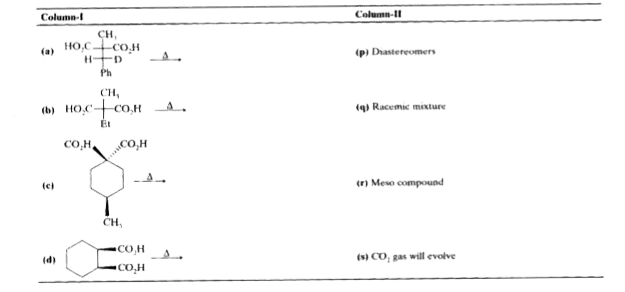ADDITIONAL OBJECTIVE QUESTIONS (Linked Comprehension Type Paragraph for Questions) from MS CHOUHAN CHEMISTRY (HINGLISH) CARBOXYLIC ACIDS AND THEIR DERIVATIVES for Class 12
| Class 12 | CHEMISTRY |
| Chapter | CARBOXYLIC ACIDS AND THEIR DERIVATIVES |
| MS CHOUHAN CHEMISTRY (HINGLISH) | ADDITIONAL OBJECTIVE QUESTIONS (Linked Comprehension Type Paragraph for Questions) |
| Medium | English |
| Academic Year | 2023-2024 |
Question 19
4 A neutral, resolvable organic compound A has molecular formula (C8H16O2). A on treatment with LiAlH4 gives isomeric B and C(C4H10O) of which only B is optically active. B on treatment with acidified dichromate solution gives D(C4H8O), which on refluxing with dilute NaOH followed by acidification of product gave E(C8H14O). E on heating with N2H4 in alkaline medium affords F(C8H16) which on treatment with B.H/H,O,/HO produced a resolvable G (C8H18O). G on treatment with acidified dichromate solution produced H(C8H16O), which on treatment with MCPBA produces A.
Compound (A) is View SolutionQuestion 20
4 A neutral, resolvable organic compound A has molecular formula (C8H16O2). A on treatment with LiAlH4 gives isomeric B and C(C4H10O) of which only B is optically active. B on treatment with acidified dichromate solution gives D(C4H8O), which on refluxing with dilute NaOH followed by acidification of product gave E(C8H14O). E on heating with N2H4 in alkaline medium affords F(C8H16) which on treatment with B.H/H,O,/HO produced a resolvable G (C8H18O). G on treatment with acidified dichromate solution produced H(C8H16O), which on treatment with MCPBA produces A.
Compound (B) is View SolutionQuestion 21
4 A neutral, resolvable organic compound A has molecular formula (C8H16O2). A on treatment with LiAlH4 gives isomeric B and C(C4H10O) of which only B is optically active. B on treatment with acidified dichromate solution gives D(C4H8O), which on refluxing with dilute NaOH followed by acidification of product gave E(C8H14O). E on heating with N2H4 in alkaline medium affords F(C8H16) which on treatment with B.H/H,O,/HO produced a resolvable G (C8H18O). G on treatment with acidified dichromate solution produced H(C8H16O), which on treatment with MCPBA produces A.
Compound (E)View SolutionQuestion 22
4 A neutral, resolvable organic compound A has molecular formula (C8H16O2). A on treatment with LiAlH4 gives isomeric B and C(C4H10O) of which only B is optically active. B on treatment with acidified dichromate solution gives D(C4H8O), which on refluxing with dilute NaOH followed by acidification of product gave E(C8H14O). E on heating with N2H4 in alkaline medium affords F(C8H16) which on treatment with B.H/H,O,/HO produced a resolvable G (C8H18O). G on treatment with acidified dichromate solution produced H(C8H16O), which on treatment with MCPBA produces A.
Compound (H) isView SolutionQuestion 23
A neutral organic compound A(C5H8O2) does not decolorize Bayer.s reagent and on hydrolysis with dilute H2SO4 produces B(C2H10O3), which is diastereomeric. B on heating with concentrated H2SO4 undergoes dehydration producing C(C5H8O2), which shows geometrical isomerism. Also B on treatment with acidic dichromate solution produced D(C5H8O2), which is enantiomeric and gives a yellow precipitate with NaOI. D on gentle heating produces E (C4H8O),which is non-resolvable.
Compound (A) isView SolutionQuestion 24
A neutral organic compound A(C5H8O2) does not decolorize Bayer.s reagent and on hydrolysis with dilute H2SO4 produces B(C2H10O3), which is diastereomeric. B on heating with concentrated H2SO4 undergoes dehydration producing C(C5H8O2), which shows geometrical isomerism. Also B on treatment with acidic dichromate solution produced D(C5H8O2), which is enantiomeric and gives a yellow precipitate with NaOI. D on gentle heating produces E (C4H8O),which is non-resolvable.
Compound (B) isView SolutionQuestion 25
A neutral organic compound A(C5H8O2) does not decolorize Bayer.s reagent and on hydrolysis with dilute H2SO4 produces B(C2H10O3), which is diastereomeric. B on heating with concentrated H2SO4 undergoes dehydration producing C(C5H8O2), which shows geometrical isomerism. Also B on treatment with acidic dichromate solution produced D(C5H8O2), which is enantiomeric and gives a yellow precipitate with NaOI. D on gentle heating produces E (C4H8O),which is non-resolvable.
Compound (C) isView SolutionQuestion 26
A neutral organic compound A(C5H8O2) does not decolorize Bayer.s reagent and on hydrolysis with dilute H2SO4 produces B(C2H10O3), which is diastereomeric. B on heating with concentrated H2SO4 undergoes dehydration producing C(C5H8O2), which shows geometrical isomerism. Also B on treatment with acidic dichromate solution produced D(C5H8O2), which is enantiomeric and gives a yellow precipitate with NaOI. D on gentle heating produces E (C4H8O),which is non-resolvable.
Compound (E)isView Solution
All Exercises from MS CHOUHAN CHEMISTRY (HINGLISH) Class 12 CHEMISTRY CARBOXYLIC ACIDS AND THEIR DERIVATIVES
- PRACTICE PROBLEM
- PRACTICE PROBLEM 17 (GENERAL PROBLEMS)
- PRACTICE PROBLEM 17 (MECHANISMS)
- PRACTICE PROBLEM 17 (REVIEW PROBLEMS) (STRUCTURE AND NOMENCLATURE)
- PRACTICE PROBLEM 17 (SYNTHESIS)
- ADDITIONAL OBJECTIVE QUESTIONS (LINKED COMPREHENSION TYPE PARAGRAPH FOR QUESTIONS)
- ADDITIONAL OBJECTIVE QUESTIONS (MATRIX MATCH TYPE)
- ADDITIONAL OBJECTIVE QUESTIONS (SINGLE CORRECT CHOICE TYPE)
- SOLVED PROBLEM









